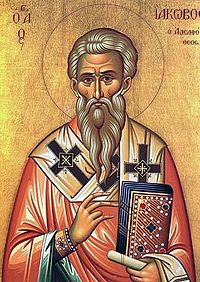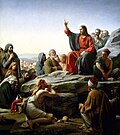The Council of Jerusalem during the Apostolic Age of the history of Christianity did not include religious male circumcision as a requirement for new gentile converts. This became known as the "Apostolic Decree" and may be one of the first acts differentiating early Christianity from Judaism. Circumcision was enjoined upon the biblical patriarch Abraham, his descendants and their slaves as "a token of the covenant" concluded with him by God for all generations, as an "everlasting covenant". ([Genesis 17:13])
Judaism background
There are numerous references in the Hebrew Bible to the obligation for circumcision. For example, Leviticus 12:3 says:
- On the eighth day a boy is to be circumcised.
And the uncircumcised are to be cut off from the covenant in Genesis 17:14:
- Any uncircumcised male, who has not been circumcised in the flesh, will be cut off from his people; he has broken my covenant.
During the 1st century BC there was a controversy in Judaism relating to whether or not a proselyte who was already circumcised needed to be ritually re-circumcised. This is done via a pinprick creating a drop of blood and is still practiced to this day.
Judaism 1st and 2nd century AD

Jewish sources vary on whether or not circumcision of proselytes was a universal practice in tannaitic times.
The disagreement centers on the correctness of contradictory passages In the Babylonian Talmud and Jerusalem Talmud and which passage is older.
B. Yevamot 46a is summarized as follows. Rabbi Joshua says that if a proselyte is immersed but not circumcised this is valid. Because our mothers where immersed but not circumcised. Rabbi Eliezer says the opposite. Because such was found regarding our fathers. However the sages say both are required.
P. Qiddushin 3:12 (3:14, 64d) is summarized as follows. Rabbi Eliezer says only circumcision is required the same as in B. Yevamot 46a. Rabbi Joshua says both are required.
During tannaitic times uncircumcised semi-converts also existed, see God-fearer and Ger toshav.
Circumcision of Jesus

According to the Gospel of Luke, Jesus was circumcised eight days after his birth, in accordance with Mosaic Law.
Mosaic Law in Early Christianity

Similar differences and disputes existed within Early Christianity, but which extended to disputes as to the place of Mosaic Law or Old Covenant in Christianity. This is particularly notable in the mid-1st century, when the circumcision controversy came to the fore. Alister McGrath, a proponent of Paleo-orthodoxy, claimed that many of the Jewish Christians were fully faithful religious Jews, only differing in their acceptance of Jesus as the Messiah. As such, they believed that circumcision and other requirements of the Mosaic Law were required for salvation. Those in the Christian community who insisted that biblical law, including laws on circumcision, continued to apply to Christians were pejoratively labeled Judaizers by their opponents and criticized as being elitist and legalistic.
The Council of Jerusalem of about 50 AD was the first meeting in early Christianity called upon to consider the application of Mosaic Law to the new community. Specifically, it had to consider whether new Gentile converts to Christianity were obligated to undergo circumcision for full membership in the Christian community, but it was conscious that the issue had wider implications, since circumcision is the "everlasting" sign of the Abrahamic Covenant. Jewish culture was still trying to find its place in the more dominant Hellenistic culture which found circumcision to be repulsive.
The decision of the Council, called the Apostolic Decree, was that most Mosaic law, including the requirement for circumcision of males, was not obligatory for Gentile converts, in order to make it easier for Jewish-Christian proselytizers to induce gentile prospects to join the Christian movement. The Council did retain the prohibitions against eating meat containing blood, or meat of animals not properly slain, and against "fornication" and "idol worship". There is a view that 'strangled' and 'blood' in the texts refer to foreskin conditions - paraphimosis and ruptured frenulum, respectively. Beginning with Augustine of Hippo, many have seen a connection to Noahide Law, while some modern scholars reject the connection to Noahide Law and instead see Leviticus 17-18 as the basis.
The Decree is one of the first acts differentiating the Church from its Jewish roots, though a similar dispute was taking place at the same time within Judaism, but which came to a contrary conclusion.
Teaching of Paul

While the issue was theoretically resolved, it continued to be a recurring issue among Christians. Four years after the Council of Jerusalem, Paul wrote to the Galatians about the issue, which had become a serious controversy in their region. There was a burgeoning movement of Judaizers in the area that advocated adherence to traditional Mosaic laws, including circumcision. According to McGrath, Paul identified James the Just as the motivating force behind the movement. Paul considered it a great threat to his doctrine of salvation through faith and addressed the issue with great detail in Galatians 3.
Paul, who called himself Apostle to the Gentiles, attacked the practice, though not consistently. In the case of Timothy, whose mother was Jewish Christian but whose father was Greek, he personally circumcised him "because of the Jews" that were in town. He also appeared to praise its value in Romans 3:1-2.
Two interpretations exist of Paul's comment on those wanting to force circumcision on Gentile Christians in Galatians 5:12. The KJV reading "I would they were even cut off" suggests cut off from the church, but most modern versions, following scholars such as Lightfoot, R. C. H. Lenski and F. F. Bruce, read as the ESV "I wish those who unsettle you would emasculate themselves!" - due to a reading of the Greek text apokopsontai "be cut off" as Paul wishing that the circumcisers would castrate themselves. This parallels κατατομή katatomÄ". Eusebius reported that the early Christian Origen did in fact castrate himself, though following Matthew 19:12.
Paul argued that circumcision no longer meant the physical, but a spiritual practice.(Romans 2:25-29) And in that sense, he wrote: "Is any man called being circumcised? let him not become uncircumcised" (1Â Corinthians 7:18) - probably a reference to the practice of epispasm
Later Paul more explicitly denounced the practice, rejecting and condemning those who promoted circumcision to Gentile Christians. Paul warned that the advocates of circumcision were "false brothers".(Gal 2:4) He accused Galatian Christians who advocated circumcision of turning from the Spirit to the flesh: "Are you so foolish, that, whereas you began in the Spirit, you would now be made perfect by the flesh?" (Gal 3:3) He accused advocates of circumcision of wanting to make a good showing in the flesh (Gal 6:12) and of glorying or boasting of the flesh (Gal 3:13). Some believe Paul wrote the entire Epistle to the Galatians attacking circumcision and any requirement for the keeping of Jewish law by Christians, saying in chapter five: "Mark my words! I, Paul, tell you that if you let yourselves be circumcised, Christ will be of no value to you at all." (Galatians 5:2).
In a late letter he warned Christians to "Beware of dogs, beware of evil workers, beware of the concision," (κατατομή, katatomÄ") saying that Christians were the true circumcision because they worshipped in the Spirit of God (Phil 3:2-3).
Florentine Bechtel (1910) The Catholic Encyclopedia: Judaizers notes: "Paul, on the other hand, not only did not object to the observance of the Mosaic Law, as long as it did not interfere with the liberty of the Gentiles, but he conformed to its prescriptions when occasion required (1Â Corinthians 9:20). Thus he shortly after circumcised Timothy (Acts 16:1-3), and he was in the very act of observing the Mosaic ritual when he was arrested at Jerusalem (Acts 21:26)."
Later views

According to Acts, Simon Peter, whom the Catholic church later called the first Pope, condemned required circumcision of converts. When the various passages from the New Testament regarding circumcision are gathered together, a strongly negative view of circumcision emerges, according to Michael Glass. Some Biblical scholars think that the Epistle to Titus, generally attributed to Paul, but see Authorship of the Pauline epistles, may state that circumcision should be discouraged among Christians, though others believe this is merely a reference to Jews. Circumcision was so closely associated with Jewish men that Jewish Christians were referred to as "those of the circumcision" or conversely Christians who were circumcised were referred to as Jewish Christians or Judaizers. These terms (circumcised/uncircumcised) are generally interpreted to mean Jews and Greeks, who were predominate, however it is an oversimplification as 1st century Iudaea Province also had some Jews who were not circumcised, and some Greeks (called Proselytes or Judaizers) and others such as Egyptians, Ethiopians, and Arabs who were.
A common interpretation of the circumcision controversy of the New Testament was, that it was over the issue of whether Gentiles could enter the Church directly or ought to first convert to Judaism. However, the Halakha of Rabbinic Judaism was still under development at this time, as the Jewish Encyclopedia notes: "Jesus, however, does not appear to have taken into account the fact that the Halakha was at this period just becoming crystallized, and that much variation existed as to its definite form; the disputes of the Bet Hillel and Bet Shammai were occurring about the time of his maturity." This controversy was fought largely between opposing groups of Christians who were themselves ethnically Jewish, see section Jewish background above. According to this interpretation, those who felt that conversion to Judaism was a prerequisite for Church membership were eventually condemned by Paul as "Judaizing teachers".
The source of this interpretation is unknown; however, it appears related to Supersessionism or Hyperdispensationalism (see also New Perspective on Paul). In addition, modern Christians, such as Ethiopian Orthodox and Coptic Orthodox still practice circumcision while not considering it a part of conversion to Judaism, nor do they consider themselves to be Jews or Jewish Christians.
The Jewish Encyclopedia article on Gentile: Gentiles May Not Be Taught the Torah notes the following reconciliation:
Contemporary practices
Today, most Christian denominations are neutral about ritual male circumcision, neither requiring it nor forbidding it. The practice is customary among the Coptic, Ethiopian, and Eritrean Orthodox Churches, and also some other African churches. Some Christian churches in South Africa oppose circumcision, viewing it as a pagan ritual, while others, including the Nomiya church in Kenya, require circumcision for membership. Some participants in focus group discussions in Zambia and Malawi said that Christians should practice circumcision because Jesus was circumcised and the Bible teaches the practice.
The Greek Orthodox Church celebrates the Circumcision of Christ on 1 January, while Orthodox churches following the Julian calendar celebrate it on 14 January. The Orthodox Church considers it one of the twelve "Great Feasts". In the Catholic, Anglican and Lutheran churches, the commemoration of the circumcision of Christ has been replaced by other commemorations.
See also
- Christianity and Judaism
- Relations between early Christianity and Judaism
- Expounding of the Law
- Religious male circumcision
- Circumcision controversies
References

External links

- Jewish Encyclopedia: Circumcision
- Catholic Encyclopedia: Circumcision
- Gentiles and Circumcision
